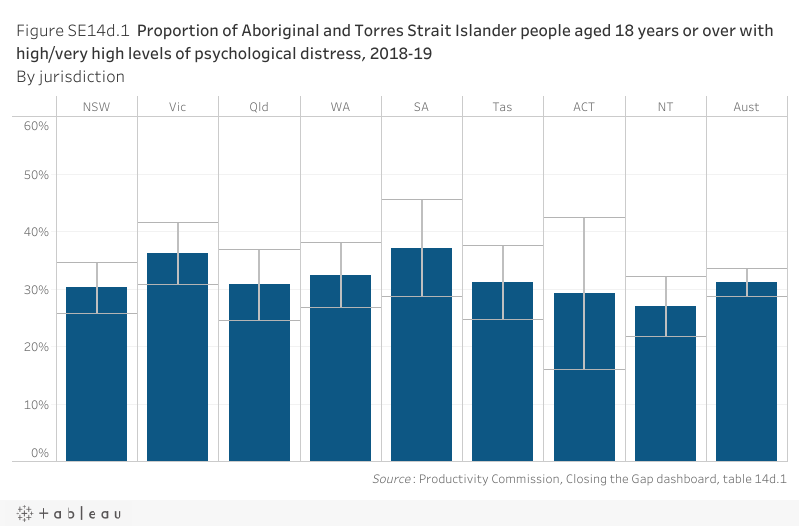Contextual information
Proportion of Aboriginal and Torres Strait Islander people reporting experiencing psychological distress
Data tables appear under figures
Measure
Proportion of Aboriginal and Torres Strait Islander people reporting experiencing psychological distress
Nationally in 2018-19, 31.1% of Aboriginal and Torres Strait Islander people aged 18 years or over reported having high/very high levels of psychological distress. The proportions were similar across states and territories (figure SE14d.1).

Indicator data specifications
Related outcome: | Aboriginal and Torres Strait Islander people enjoy high levels of social and emotional wellbeing. |
|---|---|
Related target: | Significant and sustained reduction in suicide of Aboriginal and Torres Strait Islander people towards zero. |
Indicator: | Proportion of Aboriginal and Torres Strait islander people reporting experiencing psychological distress. |
Measure: | Numerator – number of Aboriginal and Torres Strait Islander people (aged 18 years or over) reporting high/very high psychological distress, according to the Kessler 5 score scale Denominator – total number of Aboriginal and Torres Strait Islander people in the population (aged 18 years or over) and is presented as a percentage. |
Indicator established: | National Agreement on Closing the Gap July 2020 |
Latest dashboard update for the indicator: | 15 June 2023 |
Indicator type: | Contextual information |
Interpretation of change: | A low or decreasing proportion is desirable. |
Data source: | Name: National Aboriginal and Torres Strait Islander Health Survey (NATSIHS)/National Health Survey (NHS) (non‑Indigenous) Frequency: Periodic Documentation (links): https://www.abs.gov.au/statistics/people/aboriginal-and-torres-strait-islander-peoples/national-aboriginal-and-torres-strait-islander-health-survey/2018-19 |
Data provider: | Provider name: Australian Bureau of Statistics Provider area: Centre for Aboriginal and Torres Strait Islander Statistics |
Baseline year: | 2018–19 (2017–18 non‑Indigenous) |
Latest reporting period | 2018–19 (2017–18 non‑Indigenous) |
Disaggregations: | State and territory, and Australia, by Indigenous status. |
Computation: | Numerator divided by Denominator multiplied by 100. Counting rules The data relates to people aged 18 years or over living in private dwellings in remote and non‑remote areas of Australia, including discrete Indigenous communities. The data for non‑Indigenous people exclude people from very remote areas. Geographical variables are based on a person's place of usual residence. Numerator The Kessler‑5 (K5) measure of psychological distress is a subset of five questions from the Kessler Psychological Distress Scale‑10 (K10). The K10 is a non‑specific psychological distress scale consisting of 10 questions designed to measure levels of negative emotional states experienced by people in the four weeks prior to interview. The K5 provides a broad measure of people's social and emotional wellbeing. Responses to the K5 questions are combined to form a K5 score, with a minimum possible score of five and the maximum possible score of 25. Low scores indicate low levels of psychological distress and high scores indicate high levels of psychological distress. Scores were grouped and output as follows:
Supporting calculations 95% confidence intervals. See ‘How to interpret the data’ for further information: https://www.pc.gov.au/closing-the-gap-data/how-to/interpret-data. |
Data quality considerations: | Estimates that have a relative standard error between 25% and 50% should be used with caution. Estimates with a relative standard error of 50% or more are considered too unreliable for general use. See NATSIHS explanatory notes for further information: https://www.abs.gov.au/methodologies/national-aboriginal-and-torres-strait-islander-health-survey-methodology/2018-19 The data values have been randomly adjusted to avoid the release of confidential data. Discrepancies may occur between sums of the component items and totals. |
Future reporting: | Additional disaggregations required for future reporting:
|
